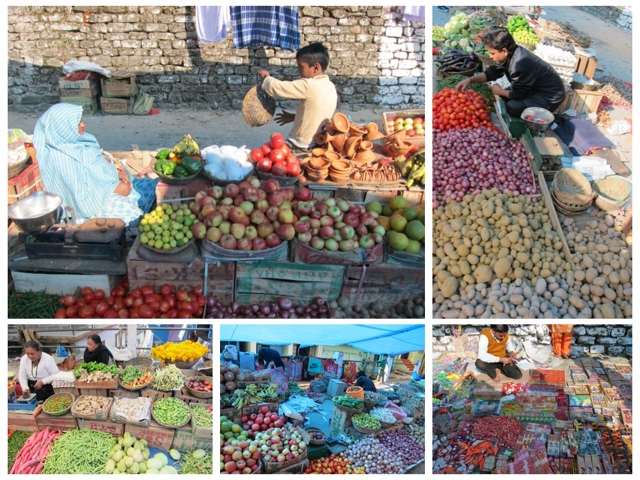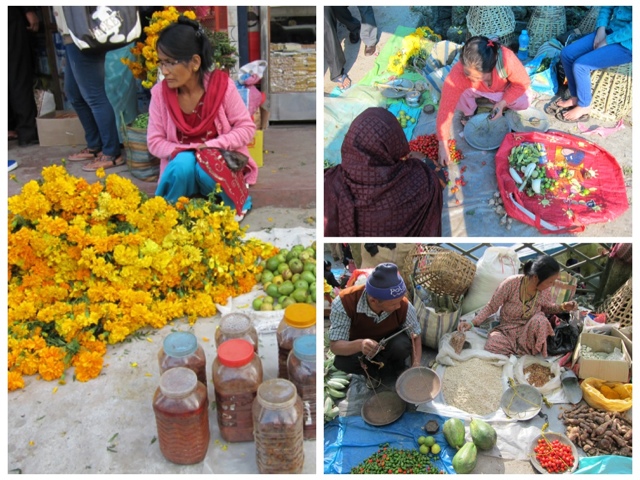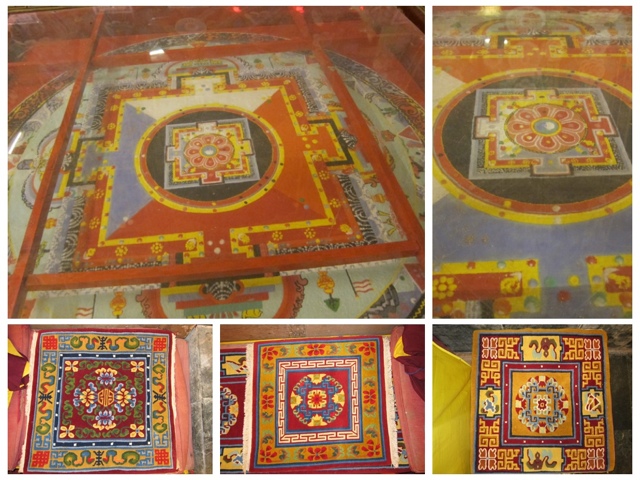The village of Kewzing, the market town of Rabangla, and a visit to the Ralang, black hat Buddhist monastery in Sikkim
The road towards Kewzing descended as we approached the Rangit River Valley in a series of hairpin turns.
After we crossed the ancient Rangit river, we drove up to Rabangla pass, and ascended once again through the steep mountains to Kewzing village.
In Kewizing, we had a most enjoyable visit at the only Bon religion monastery in Sikkim.
I was eager to learn more about the ancient Bon Religion, from which Tibetan Buddhism had emerged in Tibet.
The Bon religion predates Buddhism by thousands of years, and most of what is known about it is shrouded in mystery....
The sacred holy Bon scriptures were not allowed to ever be translated into any other language, and very little that is written about them is accurate.
I was not sure that a visit of a few hours and a conversation with the monks would result in shedding much light on this complex ancient religion.... But if you only have a chance to read bits and pieces of rumors and vague information in English, you might as well get it from someone who lives it daily....
When a friendly monk volunteered to explain some of the Bon religion to us, we bombarded him with questions, and our sincere and honest thirst to learn more about the religion he lived daily made him willing to share.
Even when the bell rang for lunchtime, he did not go to eat, but stayed with us and answered all our questions.
After lunch we went for a long walk to the Mamrung monastery, located on a ridge.
An old lady walked by us to offer her afternoon prayers at the temple.
The monastery was newly built 45 years ago, and it had great art on the walls.
The old lady went over to the monks' living quarters and brought over a shy boy with a large set of keys, who opened the temple doors for us.
On our walk back to the village, we visited the local Kewzing community monastery which was widely open, with a few young monks living in it.
The temple was built by our host family at the Bon Farmhouse.
The monks had a very spartan kitchen with only two spices and salt, and almost no sacks of rice.
But they did not seem to be suffering from hunger or deprivation; maybe they were getting fed hot food by the local old ladies, because most of them seemed too young to be able to cook for themselves.
We stayed at the Bon Farmhouse, in a lovely small cottage.
The other guests in the cottage next to us were a British couple that we had befriended in Darjeeling.
We shared experiences and had a lovely chat.
Our dinner at was served at a communal table in the farmhouse.
We had green eggplant from their garden, potatoes and vegetable momos (dumplings) with a local cottage cheese and chutney.
Our host gave us the large heater from the dining room, and we slept well and warmly in our cozy cottage.
In the morning we could see magnificent views of Mount Narsing and Mount Kabru.
We visited the hill town of Ravangla (also spelled Rabangla) and saw the big Buddha statue which was still under construction on a huge and peaceful hill overlooking the town and the mountains.
We visited the old Ralang monastery which was undergoing much reconstruction.
In the area, we were able to see old Lepcha and Butia houses, built from wood on a platform of stone foundations.
The stone foundation does not go down to the ground, but sits just above the ground, and amazingly, most of those old houses have survived hundred of years of earthquakes.
The NEW Ralang monastery was a beautiful large temple, buzzing with activity and monks.
A major Puja was gong on, and the monks, who were wearing festive outfits, performed a dance in the courtyard.
The Ralang monastery belongs to the black hat sect of Buddhism.
It is called the Kargyu sect.
The Dalai Lama belongs to the yellow hat sect of Buddhism, also known as the Nyingmapa (also spelled Nyingma in Bhutan).
The new Ralang monastery was built with the same design and colors as the famous Rumtek monastery outside of Gangtok.
The Rumtek Monastery also belongs to the Kargyu black hat sect, and in fact, up at the Rumtek monastery, there is a safe room which houses the very first black hat that was created by the first Karmapa who constructed it from hundreds of strands of black hairs given to him by guardian spirits.
This black hat is believed to be magical, and it is believed that it will fly away and disappear, if not held down by the person who wears it, or locked in a safe box.
At the courtyard of the Ralang monastery, we enjoyed looking at the dancing monks.
After a long while, we had a chance to examine the beautiful temple hall, while they were still outside dancing.
The interior of the temple was absolutely awe inspiring.
The walls were lined with beautiful scroll paintings and murals.
The altars were filled with butter and wax sculptures that were created with such artistic spirit....
Behind the large throne for the Lamas, stood a golden Buddha, and an intricately made sand mandala.
The empty seats had the monks' daily saffron robes on them, and the musical instruments stood next to the old scripture books, covered with beautiful silk fabrics.
I walked through, admiring this beautiful temple hall, feeling blessed and with complete peace of mind as I listened to the chanting of the monks... The thumping of the dancing monks' legs as they danced outside in the courtyard.
After a long time we left this beautiful monastery and joined our driver and guide, who were busy buying warm coats from two women who had set up a clothing shop by the side of the road.
Almost all the coats and clothing they had were knock-offs of major American outdoor brands, only at a fraction of the price.
The driver, our guide, and even Jules bought something warm to wear.
Back in the busy market town of Ravangla, we went for a walk through the busy market streets.
Villagers and vendors from all over the area came to sell garlands of flowers for the festival of Diwali, locally grown vegetables, spices, toys, fabrics, blankets, and so much more.
In the late afternoon, we went for a Nature trek through the old forest to Doling Monastery.
Our host and the owner of the Bon farmhouse, joined us on this lovely trek.
The beautiful forest trail passed through Kewzing Village and we saw some farms and rice and cardamom fields.
This trek used to be the old pony trail used as the main road, before they built the new road.
Today the path is a narrow and overgrown walking lane, wide enough for one person to walk at a time.
In a few places on the path, we saw some very old Buddhist stupas, and stone walls that are called Manideng.
Those stone walls had the mantra "OM Mani Padme Hum" written on them, and this is why they were known as the Mani Walls.
The mantra carried the prayers of the pilgrims who walked on this path, and ensured a safe journey.
We passed over some small streams by walking on shaky log bridges, and climbed up through a thick forest of pine, bamboo, rhododendron and oak.
The small farm houses that we passed by, all had prayer flags blowing in the wind, and I was told that most of the people in Kewizing village belong to the Bhutia caste, and that they were all Buddhists.
The Doling Monastery was closed, and we could not find anyone to open the door.
From a distance, I could hear the monks playing football, but I did not really care to go and ask one of them to open the temple's doors for us.
I went on this forest hike for the sake of the hike.
I wanted to be outdoors and to walk through the forest, which made for a very enjoyable afternoon.
Night falls very fast in this season.
By 5PM it is almost completely dark and I was happy to be back on the farm, to have a hot dinner, and to crawl into bed in our heated little cottage.
After we crossed the ancient Rangit river, we drove up to Rabangla pass, and ascended once again through the steep mountains to Kewzing village.
In Kewizing, we had a most enjoyable visit at the only Bon religion monastery in Sikkim.
I was eager to learn more about the ancient Bon Religion, from which Tibetan Buddhism had emerged in Tibet.
The Bon religion predates Buddhism by thousands of years, and most of what is known about it is shrouded in mystery....
The sacred holy Bon scriptures were not allowed to ever be translated into any other language, and very little that is written about them is accurate.
I was not sure that a visit of a few hours and a conversation with the monks would result in shedding much light on this complex ancient religion.... But if you only have a chance to read bits and pieces of rumors and vague information in English, you might as well get it from someone who lives it daily....
When a friendly monk volunteered to explain some of the Bon religion to us, we bombarded him with questions, and our sincere and honest thirst to learn more about the religion he lived daily made him willing to share.
Even when the bell rang for lunchtime, he did not go to eat, but stayed with us and answered all our questions.
After lunch we went for a long walk to the Mamrung monastery, located on a ridge.
An old lady walked by us to offer her afternoon prayers at the temple.
The monastery was newly built 45 years ago, and it had great art on the walls.
The old lady went over to the monks' living quarters and brought over a shy boy with a large set of keys, who opened the temple doors for us.
On our walk back to the village, we visited the local Kewzing community monastery which was widely open, with a few young monks living in it.
The temple was built by our host family at the Bon Farmhouse.
The monks had a very spartan kitchen with only two spices and salt, and almost no sacks of rice.
But they did not seem to be suffering from hunger or deprivation; maybe they were getting fed hot food by the local old ladies, because most of them seemed too young to be able to cook for themselves.
We stayed at the Bon Farmhouse, in a lovely small cottage.
The other guests in the cottage next to us were a British couple that we had befriended in Darjeeling.
We shared experiences and had a lovely chat.
Our dinner at was served at a communal table in the farmhouse.
We had green eggplant from their garden, potatoes and vegetable momos (dumplings) with a local cottage cheese and chutney.
Our host gave us the large heater from the dining room, and we slept well and warmly in our cozy cottage.
In the morning we could see magnificent views of Mount Narsing and Mount Kabru.
We visited the hill town of Ravangla (also spelled Rabangla) and saw the big Buddha statue which was still under construction on a huge and peaceful hill overlooking the town and the mountains.
We visited the old Ralang monastery which was undergoing much reconstruction.
In the area, we were able to see old Lepcha and Butia houses, built from wood on a platform of stone foundations.
The stone foundation does not go down to the ground, but sits just above the ground, and amazingly, most of those old houses have survived hundred of years of earthquakes.
The NEW Ralang monastery was a beautiful large temple, buzzing with activity and monks.
A major Puja was gong on, and the monks, who were wearing festive outfits, performed a dance in the courtyard.
The Ralang monastery belongs to the black hat sect of Buddhism.
It is called the Kargyu sect.
The Dalai Lama belongs to the yellow hat sect of Buddhism, also known as the Nyingmapa (also spelled Nyingma in Bhutan).
The new Ralang monastery was built with the same design and colors as the famous Rumtek monastery outside of Gangtok.
The Rumtek Monastery also belongs to the Kargyu black hat sect, and in fact, up at the Rumtek monastery, there is a safe room which houses the very first black hat that was created by the first Karmapa who constructed it from hundreds of strands of black hairs given to him by guardian spirits.
This black hat is believed to be magical, and it is believed that it will fly away and disappear, if not held down by the person who wears it, or locked in a safe box.
At the courtyard of the Ralang monastery, we enjoyed looking at the dancing monks.
After a long while, we had a chance to examine the beautiful temple hall, while they were still outside dancing.
The interior of the temple was absolutely awe inspiring.
The walls were lined with beautiful scroll paintings and murals.
The altars were filled with butter and wax sculptures that were created with such artistic spirit....
Behind the large throne for the Lamas, stood a golden Buddha, and an intricately made sand mandala.
The empty seats had the monks' daily saffron robes on them, and the musical instruments stood next to the old scripture books, covered with beautiful silk fabrics.
I walked through, admiring this beautiful temple hall, feeling blessed and with complete peace of mind as I listened to the chanting of the monks... The thumping of the dancing monks' legs as they danced outside in the courtyard.
After a long time we left this beautiful monastery and joined our driver and guide, who were busy buying warm coats from two women who had set up a clothing shop by the side of the road.
Almost all the coats and clothing they had were knock-offs of major American outdoor brands, only at a fraction of the price.
The driver, our guide, and even Jules bought something warm to wear.
Back in the busy market town of Ravangla, we went for a walk through the busy market streets.
Villagers and vendors from all over the area came to sell garlands of flowers for the festival of Diwali, locally grown vegetables, spices, toys, fabrics, blankets, and so much more.
In the late afternoon, we went for a Nature trek through the old forest to Doling Monastery.
Our host and the owner of the Bon farmhouse, joined us on this lovely trek.
The beautiful forest trail passed through Kewzing Village and we saw some farms and rice and cardamom fields.
This trek used to be the old pony trail used as the main road, before they built the new road.
Today the path is a narrow and overgrown walking lane, wide enough for one person to walk at a time.
In a few places on the path, we saw some very old Buddhist stupas, and stone walls that are called Manideng.
Those stone walls had the mantra "OM Mani Padme Hum" written on them, and this is why they were known as the Mani Walls.
The mantra carried the prayers of the pilgrims who walked on this path, and ensured a safe journey.
We passed over some small streams by walking on shaky log bridges, and climbed up through a thick forest of pine, bamboo, rhododendron and oak.
The small farm houses that we passed by, all had prayer flags blowing in the wind, and I was told that most of the people in Kewizing village belong to the Bhutia caste, and that they were all Buddhists.
The Doling Monastery was closed, and we could not find anyone to open the door.
From a distance, I could hear the monks playing football, but I did not really care to go and ask one of them to open the temple's doors for us.
I went on this forest hike for the sake of the hike.
I wanted to be outdoors and to walk through the forest, which made for a very enjoyable afternoon.
Night falls very fast in this season.
By 5PM it is almost completely dark and I was happy to be back on the farm, to have a hot dinner, and to crawl into bed in our heated little cottage.






































